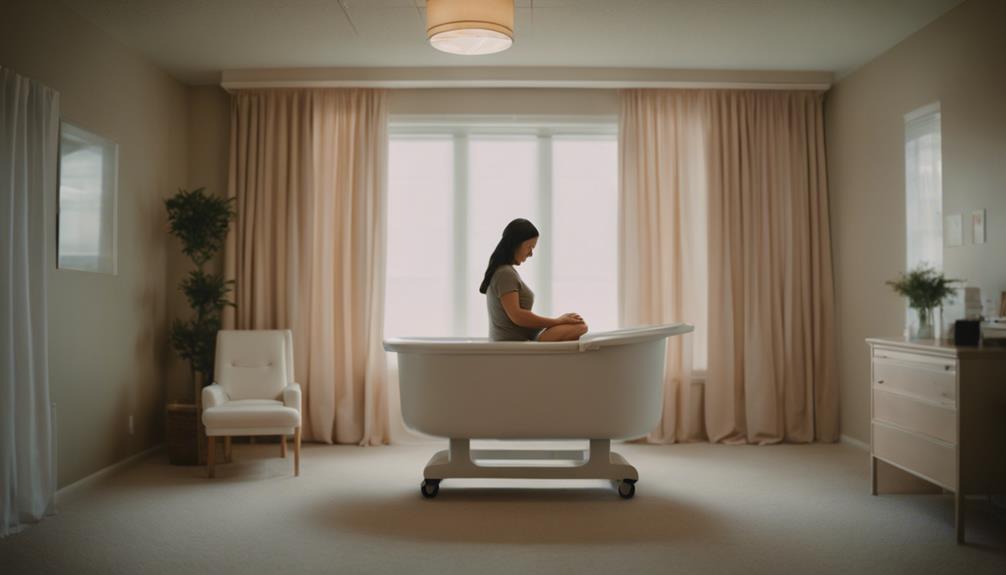
In the domain of labor hypnosis, the integration of guided imagery techniques stands as a beacon of promise, offering a pathway to heightened relaxation and pain management. The fusion of these two modalities opens up a world of possibilities, where individuals can tap into their inner reserves to navigate the challenges of childbirth with grace and empowerment. By delving into the intricate dance between visualization and hypnotic suggestion, a world of untapped potential awaits those seeking a deeper understanding of how the mind can influence the birthing experience.
Benefits of Guided Imagery in Labor
Guided imagery in labor offers a remarkable array of benefits, encompassing stress reduction, pain alleviation, and enhanced relaxation for both the mother and baby. This relaxation technique, often taught during antenatal education, serves as a powerful tool for pain management and coping strategies during labor.
By engaging in guided imagery, mothers can transport themselves to a serene mental landscape, visualizing a calm and peaceful place that helps alleviate anxiety and stress associated with childbirth. Through deep breathing and muscle relaxation techniques, guided imagery not only aids in pain management but also lowers blood pressure, enhances oxygenation throughout the body, and assists in facing the challenges of labor.
Furthermore, when partnered with a doula or support person, the benefits of guided imagery can be further amplified, providing additional emotional support and encouragement during the birthing process. Regular practice of guided imagery not only prepares mothers for delivery but also equips them with a valuable life skill for managing stress and promoting overall well-being.
Techniques for Sensory Visualization
Exploring the world of sensory visualization techniques opens a gateway to enhancing the depth and effectiveness of hypnosis during labor, offering a holistic approach to pain management and relaxation. Sensory visualization involves stimulating all senses to create a vivid mental image during labor hypnosis. By incorporating detailed descriptions of sights, smells, tastes, and sounds into the visualization process, guided imagery becomes more potent. This heightened sensory experience not only improves focus but also aids in relaxation and pain management during labor.
Engaging in sensory visualization allows individuals to immerse themselves deeply in the imagined environment, fostering a sense of tranquility and calmness. By including elements like touch, movement, and temperature in guided imagery, the hypnotic experience is intensified, leading to enhanced pain relief. These techniques provide a powerful tool for individuals seeking to optimize their hypnosis experience during labor, promoting a sense of control and well-being through the power of sensory visualization.
Partner's Role in Visualization

Partners can be invaluable allies in enhancing the visualization experience during labor by providing a supportive presence and encouraging positive imagery.
Their active involvement in painting a detailed mental picture can help the laboring individual immerse themselves in a calming and serene environment, fostering relaxation and a positive mindset.
Collaborating with a partner in guided imagery exercises not only deepens the bond between them but also contributes to a more profound and fulfilling birthing experience.
Supportive Presence During Labor
Supporting the laboring individual through detailed sensory descriptions can greatly enhance the effectiveness of guided imagery techniques during childbirth. Partners play an important role in visualization, involving all senses to create a vivid and immersive experience. By describing a detailed positive experience, hesitant individuals can relax and engage more effectively in the visualization process.
Additionally, creating an ideal environment through visualization techniques can address stress, tension, and fears during labor. Visualizing the labor process, including internal aspects like the cervix opening, aids in relaxation and understanding of the birthing experience.
- Partners provide detailed sensory descriptions to enhance visualization.
- Involving all senses creates a vivid and immersive experience.
- Describing a positive experience helps individuals relax and engage effectively.
- Creating an ideal environment through visualization techniques addresses stress and fears.
Encouraging Positive Imagery
Enhancing the laboring individual's guided imagery experience involves skillfully weaving together sensory details provided by a partner to create a deeply immersive and soothing visualization during childbirth. Partners play an essential role in describing sights, smells, tastes, and sounds to enhance vivid visualization, contributing to an immersive experience.
By involving all senses in crafting the visualization, a more realistic and comforting environment can be created, leading to stress reduction and a supportive atmosphere during labor. Collaborating with a partner to paint a detailed and peaceful scene not only aids in relaxation but also provides coping strategies for the birthing individual.
This partnership in creating a supportive and encouraging visualization can greatly improve the birth experience, fostering feelings of relaxation and well-being for the mother.
Using Positive Memories for Relaxation
Drawing upon positive memories through guided imagery can greatly contribute to relaxation and comfort during labor. When using positive memories for relaxation, individuals can transport themselves to a place of peace and tranquility, easing the stress and discomfort often associated with labor. Here are four ways positive memories can be harnessed for relaxation during this important time:
- Reliving Pleasant Experiences: Recreating a positive experience through guided imagery allows individuals to tap into feelings of joy and contentment, promoting relaxation.
- Visualizing Serene Environments: By visualizing scenes from a happy memory, individuals can create a mental space filled with calmness and relaxation.
- Engaging All Senses: Involving all senses in the visualization process, such as describing sights, smells, tastes, and sounds, enhances the immersive quality of the experience, making it more effective.
- Stress Reduction: Painting a vivid and detailed picture of a positive memory can aid in reducing stress levels, providing a sense of comfort and peace during labor.
Visualizing Internal Labor Processes
Visualizing internal labor processes through guided imagery can empower women to connect with their bodies and navigate the intricate stages of childbirth with a sense of purpose.
By employing breathing techniques, visualization, and muscle relaxation imagery, expectant mothers can cultivate a serene mental space amidst the physical intensity of labor.
These powerful visualization tools offer women a calming anchor, fostering resilience and control throughout the birthing journey.
Breathing Techniques Visualization
Understanding the intricate connection between breathing techniques and visualizing internal labor processes can empower women to navigate childbirth with strength and composure. When it comes to incorporating breathing techniques visualization for pain management during labor, consider the following:
- Imagining the Breath: Visualizing each breath as a wave of relaxation flowing through the body can enhance relaxation and reduce discomfort.
- Syncing Breathing with Contractions: Matching breathing patterns with the intensity of contractions can help women stay focused and grounded.
- Incorporating Affirmations: Combining positive affirmations with breathing techniques visualization can boost confidence and reduce anxiety.
- Partner Support: Having a partner assist in guiding breathing techniques visualization can deepen relaxation and create a supportive birthing environment.
Muscle Relaxation Imagery
To deepen the connection between mind and body during labor, exploring muscle relaxation imagery can offer a profound way to enhance relaxation and reduce tension. This technique involves visualizing the internal processes of labor, such as the cervix opening, to promote a sense of calm and understanding of the changes occurring in the body.
By using metaphors like a turtleneck or a flower bud, individuals can ease into a state of relaxation during labor. Choosing inanimate objects to focus on during visualization can further enhance the effectiveness of muscle relaxation imagery.
Incorporating this technique into childbirth classes can be invaluable in preparing individuals for the labor experience, providing them with essential relaxation techniques to aid in a smoother delivery.
Options for Focused Imagery
Enhancing the depth of relaxation and pain management during labor, focused imagery techniques in hypnosis involve the creation of intricate mental scenes rich in sensory details. This method allows individuals to visualize a calming environment that can positively impact their childbirth experience.
To enhance the effectiveness of focused imagery during labor, consider the following options:
- Visualization: Encourage the individual to visualize a serene and tranquil setting, incorporating elements like gentle waves or a peaceful forest to promote relaxation.
- Sensory Details: Emphasize the importance of including sensory details such as the sound of birds chirping, the warmth of sunlight, or the scent of flowers blooming to make the imagery more vivid and engaging.
- Partner Involvement: Involve the partner in describing sights, sounds, and sensations to deepen the immersive experience and provide additional support during labor.
- Guided Imagery in Childbirth Classes: Integrate guided imagery exercises into childbirth classes to help individuals practice and refine their visualization skills, preparing them for the use of focused imagery during labor.
Trusted Sources for Information

Trusted sources like Verywell Family offer invaluable insights into the use of hypnosis for pain management during labor and childbirth. They provide evidence-based guidance for expectant mothers seeking effective techniques to enhance their birthing experience. These authoritative sources not only provide information on hypnosis techniques but also explore the integration of guided imagery to alleviate labor pain.
Peer-reviewed studies back the effectiveness of hypnosis in managing labor pain, ensuring the reliability of the content provided. Editorial processes employed by these sources guarantee accuracy, making them a go-to for those exploring guided imagery techniques for hypnosis during labor.
Studies on Guided Imagery With Hypnosis
Studies conducted on the efficacy of guided imagery combined with hypnosis during labor have consistently shown promising results in enhancing pain management and relaxation for expectant mothers.
When it comes to the use of guided imagery techniques with hypnosis for pain management and relaxation during labor, here are some key findings:
- Improved Pain Management: Research indicates that the combination of guided imagery and hypnosis can markedly reduce the perception of pain during labor, offering women a more comfortable birthing experience.
- Enhanced Relaxation: Studies have demonstrated that guided imagery used in conjunction with hypnosis promotes deep relaxation, helping women remain calm and composed throughout the labor process.
- Positive Birth Experiences: Incorporating guided imagery into hypnosis practices has been linked to more positive overall birth experiences for women, fostering a sense of empowerment and control.
- Stress Reduction and Coping Strategies: Evidence suggests that utilizing guided imagery techniques with hypnosis equips women with effective coping mechanisms, reducing stress levels and promoting a smoother labor journey.
Frequently Asked Questions
What Is the Hypnosis Technique of Labor?
The hypnosis technique of labor involves utilizing visualization techniques, relaxation exercises, breathing techniques, positive affirmations, and strengthening the mind-body connection.
By focusing on these aspects, individuals can enter a state of heightened relaxation and concentration, helping to reduce fear, anxiety, and pain perception during childbirth.
This technique aims to promote a positive birth experience by enhancing pain management strategies and overall well-being for the laboring individual.
Which Childbirth Method Involves a Form of Self-Hypnosis?
HypnoBirthing is a childbirth method that involves a form of self-hypnosis. Through self-hypnosis techniques, relaxation exercises, visualization methods, and mindfulness practices, HypnoBirthing teaches women to enter a state of deep relaxation during labor.
What Is Hypnotherapy for Inducing Labor?
Hypnotherapy for inducing labor is a holistic approach that leverages relaxation techniques, visualization methods, and positive affirmations to foster a calm and comfortable birthing experience. By tapping into the mind-body connection, hypnosis benefits expectant mothers by reducing stress, anxiety, and pain during labor.
This approach empowers women to feel more in control, confident, and prepared for childbirth, while also offering effective pain management strategies for a smoother birthing process.
What Is Hypnosis in Pregnancy?
Hypnosis in pregnancy involves utilizing relaxation techniques, visualization exercises, and breathing exercises to tap into the mind-body connection. It aims to reduce fear, anxiety, and pain during labor, promoting a positive birth experience.
By incorporating pain management strategies, hypnosis helps women manage discomfort and increase feelings of control. Research supports its effectiveness in reducing pain perception and improving overall well-being during childbirth.
What transformative power lies within the domain of hypnosis during pregnancy?
Conclusion
In summary, guided imagery techniques offer a powerful tool for enhancing hypnosis during labor, providing pain alleviation, relaxation, and emotional support.
By incorporating detailed sensory visualization and positive imagery, individuals can deepen their coping strategies and achieve a heightened sense of control during the birthing process.
Partners play an important role in supporting this process, ultimately fostering a fulfilling and empowering experience for all involved.
Trust in the power of guided imagery to transform your labor experience.




